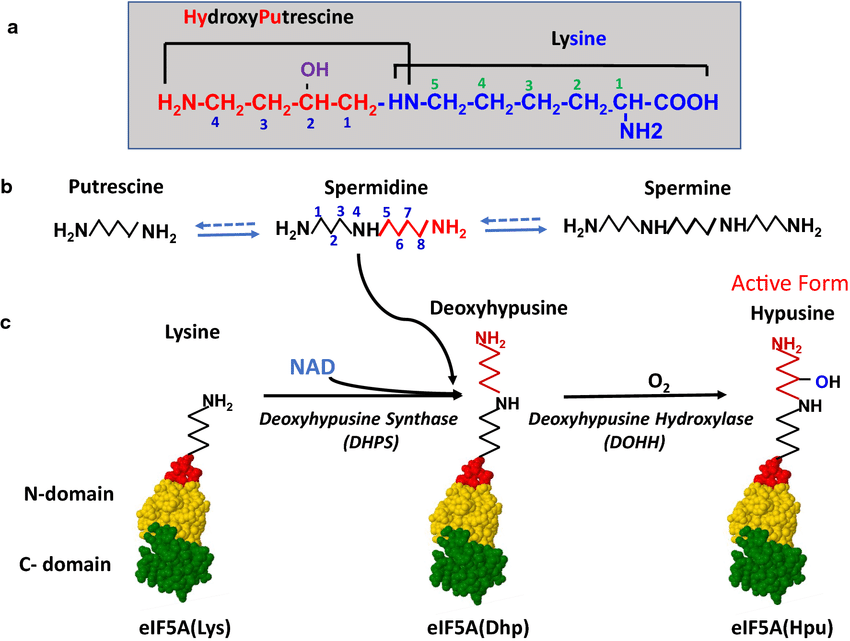Hypusine Formation Analysis Service
Hypusine, a rare lysine-derived post-translational modification found exclusively on eukaryotic initiation factor 5A (eIF5A), plays a pivotal role in translation elongation, cell proliferation, and disease pathogenesis. The Hypusine Formation Analysis Service from MtoZ Biolabs provides researchers with a robust analytical platform that combines high-resolution mass spectrometry, targeted immunoenrichment, and pathway-based bioinformatics to systematically investigate hypusination dynamics.
This modification is biosynthetically unique—it is generated via two sequential enzymatic steps: deoxyhypusine synthase (DHS) mediates the initial conjugation of spermidine to lysine on eIF5A to form deoxyhypusine, followed by hydroxylation via deoxyhypusine hydroxylase (DOHH) to yield active hypusine. Beyond translation, hypusine is implicated in cancer progression, neurodegeneration, and complex crosstalk with phosphorylation and acetylation signaling.

Park, M. H. et al. Amino Acids. 2021.
Figure 1. Hypusine Formation and eIF5A Activation Pathway
At MtoZ Biolabs, we leverage multi-platform workflows to decode hypusination patterns, characterize enzymatic regulation, and uncover novel PTM interactions—empowering both mechanistic and translational research.
Services at MtoZ Biolabs
Our Hypusine Formation Analysis Service supports full-spectrum analysis from peptide-level detection to functional interpretation. Our modular pipeline includes:
1. Comprehensive Hypusine Mapping
Use high-resolution Orbitrap MS to identify and distinguish lysine, deoxyhypusine, and mature hypusine states on eIF5A.
2. IP-MS–Based Protein Targeting
Enrich eIF5A or hypusinated proteins with specific antibodies and perform MS-based interactome or modification profiling.
3. Targeted Quantitative Assessment
Apply PRM/MRM methods to quantify hypusination levels across time points or treatment conditions.
4. Enzymatic Regulation Analysis
Correlate DHS/DOHH expression and activity with hypusine levels to elucidate control mechanisms.
5. Crosstalk with Other PTMs (optional)
Investigate regulatory interplay between hypusination and phosphorylation, acetylation, or ubiquitination.
6. Structural-Functional Annotation
Combine domain mapping, structural modeling, and PPI network analysis to define hypusine-dependent regulatory circuits.
Service Advantages
✅ Integrated Multi-Dimensional Analysis: Unites high-resolution MS, antibody enrichment, and pathway annotation for comprehensive hypusine profiling.
✅ Resolution of Modification States: Simultaneously detects lysine, deoxyhypusine, and hypusine to analyze enzymatic flux and modification kinetics.
✅ Quantitative and Functional Synergy: Delivers robust quantification while integrating biological interpretation via structural and pathway insights.
✅ Broad Sample Versatility: Supports mammalian cells, tissues, and bacterial systems; ideal for model comparison and translational studies.
✅ High-Data-Quality: Deep data coverage with strict data quality control. AI-powered bioinformatics platform integrate all proteomics analysis data, providing clients with a comprehensive data report.
✅ One-Time-Charge: Our pricing is transparent, no hidden fees or additional costs.
Applications
The Hypusine Formation Analysis Service is optimized for both exploratory and hypothesis-driven studies in:
· Translational Regulation: Assess how hypusine shapes eIF5A structural activation and mRNA decoding efficiency
· Cancer Biology: Profile hypusination shifts in tumor models and identify actionable biomarkers or intervention targets
· Neurodegeneration Research: Investigate the role of dysregulated hypusination in neuronal survival, synaptic plasticity, and stress response
· Drug Mechanism Evaluation: Analyze DHS/DOHH inhibitor impact on hypusination levels and downstream signaling modulation
Case Study
Case 1: Hypusine Pathway Activation Drives Pulmonary Vascular Remodeling in PAH
A 2024 study uncovered a key role for hypusine in pulmonary arterial hypertension (PAH). Using transcriptomic, proteomic, and functional tools, the researchers demonstrated that hypusinated eIF5A, DHS, and DOHH are significantly upregulated in pulmonary arterioles and PASMCs from both PAH patients and rodent models. Inhibition of DHS attenuated pathological cell proliferation and improved cardiopulmonary function. LC-MS/MS profiling revealed that hypusine signaling supports oxidative phosphorylation, linking metabolic adaptation to disease progression[1].
These results showcase how the Hypusine Formation Analysis Service can dissect PTM-regulated pathways with both mechanistic depth and translational impact—supporting biomarker discovery and therapeutic validation.
FAQ
Q1: Can intermediate hypusine forms like deoxyhypusine be distinguished?
Yes. Our curated hypusine-specific database enables simultaneous detection and quantification of lysine, deoxyhypusine, and hypusine. This is ideal for studying enzymatic dynamics and modification flux.
Q2: Can I compare hypusination levels across control and intervention groups?
Yes. We offer tailored experimental support for DHS/DOHH knockdown, small molecule inhibition, or model comparisons—allowing dynamic tracking of hypusination and functional outcomes.
At MtoZ Biolabs, we specialize in high-resolution post-translational modification analysis. Our Hypusine Formation Analysis Service offers a complete, scalable solution to support your research into eIF5A regulation and its role in disease. Contact us today for a customized proposal.
[1] Lemay, S. E. et al. Hypusine Signaling Promotes Pulmonary Vascular Remodeling in Pulmonary Arterial Hypertension. AM J RESP CRIT CARE. 2024.
How to order?







